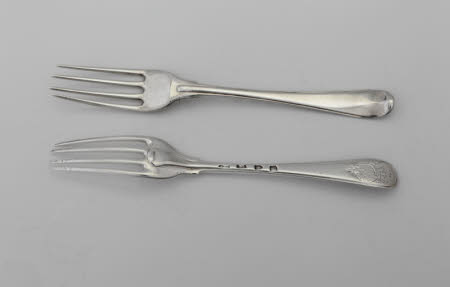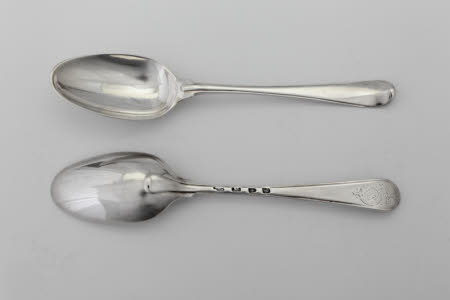Dessert forks and spoons
Paul Callard
Category
Silver
Date
1758 - 1759
Materials
Sterling silver
Measurements
17.1 cm (length, forks); 17.8 cm (length, spoons)
Place of origin
London
Order this imageCollection
Ickworth, Suffolk
NT 852098
Summary
Twenty three dessert forks and twenty three dessert spoons, sterling silver, by Paul Callard, London, 1758/9. Part of a service with dessert knives (NT 852204). The spoons and four-tined forks are of the Hanoverian pattern with reeding to the handles front and back and substantial single drops on the backs at the tine and bowl ends. Heraldry: The rear of each of the terminals is engraved with the quartered arms of the Hanoverian monarchs (pre-1801) within the Garter and beneath an imperial crown flanked by the initials G R. Hallmarks: All the forks and spoons are fully marked on the rear of the stem with maker’s mark ‘PC’ beneath two mullets and above a fleur-de-lis (Arthur Grimwade, London Goldsmiths 1697-1837, London 1990, no. 2150), lion passant, leopard’s head and date letter ‘C’. Scratchweights: None. A combined weight for two dozen of the forks and of the spoons is given in the 1811 plate list (Suffolk Record Office, ref. 941/75/1) as 39oz 8dwt and 38oz 13dwt respectively.
Full description
George Hervey, 2nd Earl of Bristol (1721-75) received two dozen dessert knives, forks and spoons in 1758 (see NT 852204 for the knives) as part of his official allocation on being sent to Spain as ambassador. As this quantity would only have sustained a party of twenty-four and Lord Bristol had adequate silver for thirty-six for the earlier courses, it is likely that he already owned either a larger set of a different pattern or at least a dozen more matching these. If so, however, none survives. The knives in particular are considerably more ornamental than those of the table service (NT 852203) and are a rare survival. The arms being engraved on the top edge suggests that they may have been laid on the table upon the knife edge, the flat base of the scroll end holding them steady. Silver blades were employed because they looked more impressive than steel and also because it was not necessary to maintain such a sharp cutting edge as for the earlier courses. Furthermore, silver would have resisted better the acids of fruit consumed during dessert. It was typical, but not universal, in the mid eighteenth century for dessert flatware and cutlery not to be gilded, even when being used with silver-gilt plates as were these.[1] By 1800 gilding was much more common as on the extensive dessert service of the future 1st Marquess of Bristol (NT 852193, 852195, 852199 & 852202).A comparable but even more elaborate contemporary service, albeit without silver blades to the knives, was supplied by Frederick Kandler to a Dutch client in the early 1750s and is now in the Museum of Fine Arts, Boston.[2] That also consisted of two dozen of each implement (subsequently augmented by Dutch copies) and has two silver-mounted cases, one for the knives and the other for the spoons and forks. ‘Half round cases’, as they were called by George Wickes, might cost £1 4s, as did those of the 4th Earl of Coventry’s new dessert service in 1757.[3] Though Lord Bristol would undoubtedly have had his service cased too, all the more so because of the need to transport it safely to Madrid, his thrifty temperament is more likely to have led to the choice of the more prosaic ‘wainscot boxes lined with bays’ used for the Marquess of Granby’s knives, forks and spoons in 1750 and costing him just four shillings each.[4] All two dozen of the knives survived in 1951 but only six passed to the National Trust together with the twenty-three each of forks and spoons remaining.[5] James Rothwell, Decorative Arts Curator May 2021 [Adapted from James Rothwell, Silver for Entertaining: The Ickworth Collection, London 2017, cat. 71, pp. 154-5] Notes: [1] The 6th Earl of Coventry’s 1757 service was supplied gilded, at a cost of 3s per implement, £10 18s in total. [2] Christopher Hartop, The Huguenot Legacy, English Silver 1680-1760, London 1996, cat. 48, pp. 226-9. A service with silver blades and with elaborately chased handles, of c.1730, is in the Ashmolean Museum: Timothy Schroder, British and Continental Gold and Silver in the Ashmolean Museum, Oxford 2009, cat. 395, pp. 920-2. [3] National Art Library, Garrard Ledgers, VAM 5 1750–4, f. 69. [4] Ibid., VAM 3 1747–50, f. 166. [5] Suffolk Record Office, HA 507/9/21, List of silver offered in lieu of tax following the death of the 4th Marquess of Bristol, c.1951, pp. 6 and 17.
Provenance
Jewel Office; allocated to George Hervey, 2nd Earl of Bristol (1721-75) as Ambassador to Madrid 1758; discharged to Lord Bristol 9 April 1759; by descent to the 4th Marquess of Bristol (1863-1951); accepted by the Treasury in lieu of death duties in 1956 and transferred to the National Trust.
Credit line
Ickworth, the Bristol Collection (National Trust)
Makers and roles
Paul Callard, goldsmith





